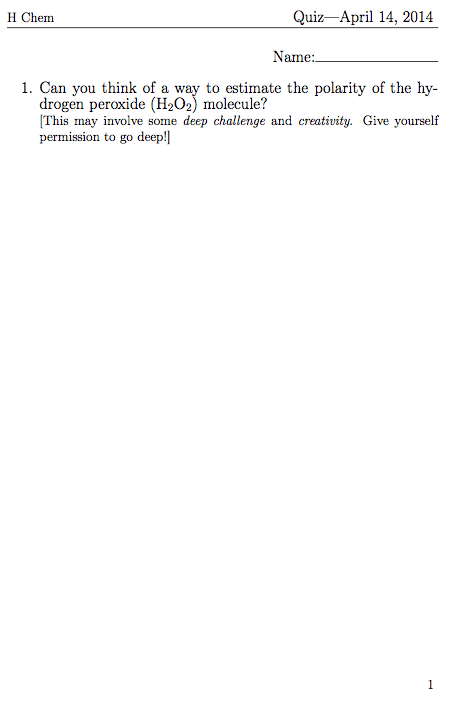The problems
After watching Cal Newport’s wonderful lecture, a question comes to mind: “If you believe that deep work is important for the development of rare and valuable skills, what is the purpose of a teacher?”
As a teacher, I confess that I don’t have an answer, but unless students spend a significant portion of the class time honing rare and valuable skills, I suspect that we are not worth the opportunity cost our students are paying. Just how steep is this opportunity cost?
Let’s assume that 10,000 hours is necessary to achieve expert status in a given field.* We can now calculate that a particular class consumes 1.5% of this number. Unless students are doing something that is truly rare, “rare and valuable” expertise can not be cultivated. Note: the average class is not doing this by the definitions of “rare” and “average”.
The summer letter
Last spring, after reading Invent to Learn, I sent out the following letter to my students. I wanted them to think about what “substantial, sharable, and personally meaningful” work might look like:
 The initial results
The initial results
This year, students have used our class’s democratic process to pass a motion allocating one period every week to their independent project work. They set up a blog** that is uniquely their own where they investigate a host of topics from the nature of glow in the dark materials to the philosophy of science. They are testing soil quality at our organic garden and doing many other projects they care about. Students have shared their demos, experiments, and essays with each other and the world. This work has been a vehicle through which they have honed many skills, including the problem-finding and problem-solving skills people value.
For the future
I want to end with a few reflections.
First, I don’t think I am rare. I am just like every other teacher who is trying to figure out what I should do in my classroom each day. But, over my four years as a teacher, the value proposition I offer has changed. When I began, I naïvely thought that my students would be experts in my field after a year with me. Today, I know that they only pass this test if I narrowly define the words “expert” and “field”.
Regarding the new discipline-specific skills, students are just beginning their mastery journey. This 1.5% represents the window I have to hook or sour them on a new pursuit. By opening up our classrooms to develop skills in concert, students tailor their education: simultaneously learning new skills and adding 1.5% to skills that were already in progress before they met me.
As teachers, we can adhere to our idiosyncratic preferences about the important topics within our disciplines, or we can offer students the opportunity to design the curriculum with us; where they choose the skills they want to hone and find a level of mastery for each skill. In short, I am asking, who gets to choose the skill set students practice? As a perpetual learner, I prefer that the students choose. ***
Endnotes
* Read this beautiful essay about expertise (PDF) by Ericsson, Prietula, and Cokely for more on this.
** No, I can’t take credit for the URL choice “onedirectionkateupton.wordpress.com” or the motto: “Come for the Celebrities, Stay for the Chemistry” both of which were chosen democratically to increase google search traffic to their site.
*** One last thought: I want to challenge the implicit notion that a student is primarily a recipient of—and secondary to—the knowledge within a field. When teachers make course decisions ahead of time, or without asking, students inevitably receive the message that the institution or the teacher knows best which rare and valuable skills they should master. I am willing to be convinced of this if student outcomes warrant it, but I refuse to accept it uncritically since the cost of the bargain is at least a measure of student autonomy—the first of Dan Pink’s motivation triumvirate.
along a path is equal to:
. I then asked a “challenge” question about how one could compute the curvature without referencing a velocity or acceleration vector. I have slightly rephrased the question below:
. So,
, and we wish to know the curvature at a point
. This is a well-defined question with no reference to a parameter,
. It is natural to wonder whether there is a way to find curvature without imposing a new parameter.
, where
is defined above.
is a circle of radius two; and the curvature at any point on this path is
, as expected since
for a circle of radius,
.









